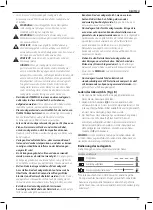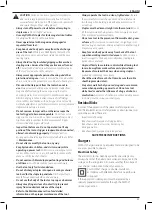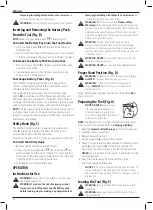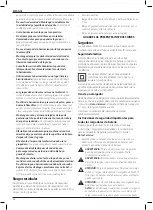
33
EnGLIsh
CAUTION:
Fasteners can miss or penetrate workpieces
and cause injury to persons! Especially if parts from the
work surface or plastic parts of the stapler can splinter off
and injure the eyes. Wear safety glasses!
•
Always turn off power to circuit before attempting to
staple wires.
Do not staple “live” wires.
•
Use only
D
e
WALT
staples for fastening electrical cables.
It is designed for electric cable installation.
•
Never operate tool with magazine disengaged or
separated from tool.
•
Keep hands and body parts away from the discharge
area of the tool.
While in use NEVER grasp the tool by the
magazine or canister, a mis-driven staple can exit the nose
causing injury.
•
Always hold tool by insulated gripping surfaces when
stapling wires. Assume that they are live even if turned
off.
Contact with a “live” wire will make exposed metal parts
of the tool “live” and shock the operator.
•
Always wear appropriate personal hearing and other
protection during use.
Under some conditions and duration
of use, noise from this product may contribute to hearing loss.
•
Disconnect battery pack from the tool when not in
use.
Always remove battery pack and remove staples from
magazine before leaving the area or passing the tool to
another operator. Do not carry tool to another work area in
which changing location involves the use of scaffoldings,
stairs, ladders, and the like, with battery pack connected. Do
not make adjustments, perform maintenance or clear jammed
staples while battery is in place.
•
Do not remove, tamper with, or otherwise cause the
tool or trigger to become inoperable.
Do not tape or tie
trigger in the on position. Do not remove spring from contact
trip. Make daily inspections for free movement of trigger.
Uncontrolled discharge could result.
•
Inspect tool before use. Do not operate a tool if any
portion of the tool or trigger is inoperable, disconnected,
altered, or not working properly.
Damaged parts or
missing parts should be repaired or replaced before use. Refer
to
Maintenance
.
•
Do not alter or modify the tool in any way.
•
Keep bystanders, children, and visitors away while
operating a power tool.
Distractions can cause you to lose
control. When tool is not in use, it should be locked in a safe
place, out of the reach of children.
•
Do not overreach. Maintain proper footing and balance
at all times.
Loss of balance may cause personal injury.
•
Use the tool only for its intended use.
•
Do not discharge staples into open air or any material
too hard for the staple to penetrate.
Discharged staple
may follow unexpected path and cause injury.
•
Do not use the body of the tool or top cap as a hammer.
•
Always keep fingers clear of contact trip to prevent
injury from inadvertent release of the staple.
•
Refer to the
Maintenance
section for detailed
information on the proper maintenance of the tool.
•
Always operate the tool in a clean, lighted area.
Be sure
the work surface is clear of any debris and be careful not to
lose footing when working in elevated environments such
as rooftops.
•
Staples must be driven straight into the material.
Do not
tilt the stapler while driving staples. Personal injury can result
from ricocheted or jammed staples.
•
Do not use tool in the presence of flammable dust, gases
or fumes.
This tool produces sparks that can ignite gases or
dust causing an explosion. Driving a staple into another staple
may also cause a spark.
•
Keep face and body parts away from back of the tool
cap when working in restricted areas.
Sudden recoil can
result in impact to the body, especially when stapling into
hard or dense material.
•
Grip tool firmly to maintain control while allowing tool
to recoil away from work surface as staple is driven.
•
Be aware of material thickness when using stapler.
A
protruding staple may cause injury.
•
Check the wire after each shot to make sure the cable
sheathing remains intact.
•
Stay alert, watch what you are doing and use common
sense when operating a power tool. Do not use tool
while tired or under the influence of drugs, alcohol, or
medication.
A moment of inattention while operating power
tools may result in serious personal injury.
Residual Risks
In spite of the application of the relevant safety regulations
and the implementation of safety devices, certain residual risks
cannot be avoided. These are:
• Impairment of hearing.
• Risk of personal injury due to flying particles.
• Risk of burns due to accessories becoming hot
during operation.
• Risk of personal injury due to prolonged use.
SAVE THESE INSTRUCTIONS
Chargers
D
e
WALT
chargers require no adjustment and are designed to be
as easy as possible to operate.
Electrical Safety
The electric motor has been designed for one voltage only.
Always check that the battery pack voltage corresponds to the
voltage on the rating plate. Also make sure that the voltage of
your charger corresponds to that of your mains.
Your
D
e
WALT
charger is double insulated in
accordance with EN60335; therefore no earth wire
is required.
If the supply cord is damaged, it must be replaced by a
specially prepared cord available through the
D
e
WALT
service organisation.
















































